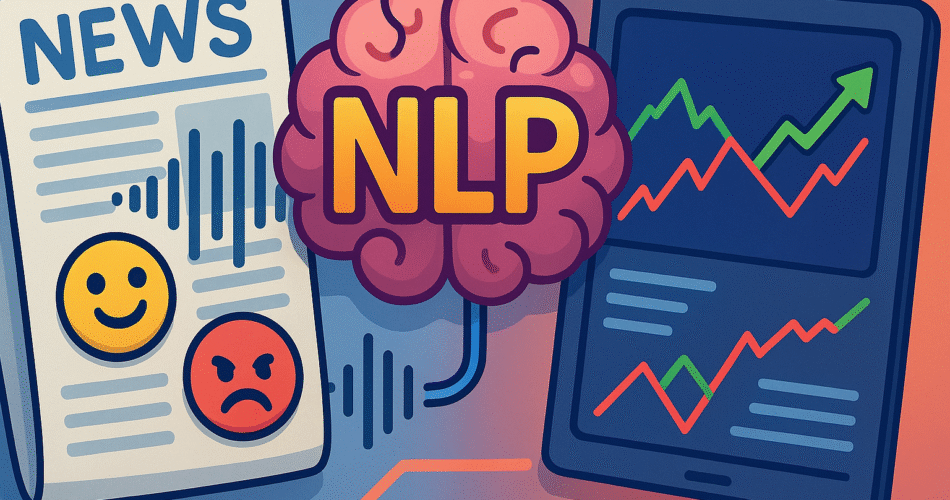In today’s age of information overload, investing decisions extend far beyond reading financial statements. Investors and analysts must gauge not only the facts—but the overall sentiment behind financial news, social media buzz, and corporate filings. This is where Natural Language Processing (NLP) steps in.
At Peaks2Tails, our mission is to empower professionals with practical quantitative tools—from Excel animations to Python workflows. A powerful example: applying NLP for sentiment analysis to capture market sentiment and gain a predictive edge.
🧠 What is NLP-based Sentiment Analysis?
Sentiment analysis (a branch of NLP) automatically interprets large bodies of text—categorizing them as positive, negative, or neutral. In finance, this means transforming unstructured textual data (like news headlines or tweets) into quantifiable signals.
How it works:
- Preprocessing: Clean raw text—strip HTML, remove stop‑words, tokenise.
- Feature Extraction: Turn words into numeric embeddings or use sentiment lexicons.
- Modeling: Use trained statistical or deep‑learning models to predict sentiment polarity.
Why It Matters in Financial Markets
1. Informed Trading and Investment Decisions
Positive—or negative—tonality in news about a stock often correlates with near-term movements. Automated sentiment scores offer traders and fund managers a data‑driven edge.
2. Algorithmic & High-Frequency Trading (HFT)
Modern systems can parse and score real‑time news feeds. In milliseconds, trades can be triggered—leverage impossible with manual monitoring .
3. Risk Management & Early Warnings
Sudden sentiment shifts around sectors or portfolios can trigger alerts—helping risk teams to adjust hedges or assess exposures.
4. Behavioral Insight & Regulatory Compliance
By instrumenting sentiment analysis across social media and filings, analysts can detect changes in investor mood—integrating this into behavioral models or monitoring compliance risks .
Technological Advances Driving Accuracy
- Transformer-based models (e.g., FinBERT, RoBERTa, GPT‐style) fine‑tuned on finance texts outperform generic.
- Entity‑aware sentiment tools—like SEntFiN—can assess multiple companies in a single headline.
- Domain‑specific fine‑tuning (ex: Gemma-7B applied to news headlines) delivers high F1 accuracy on financial sentiment.
Challenges You’ll Encounter
- Finance-specific language—terms like “bearish,” “yield curve” or “dividend cut” demand a tailored model.
- Sarcasm, irony, and ambiguity—even state-of-the-art systems can misread tone.
- Data freshness—models need continuous updating as market sentiment evolves.
- Latency vs accuracy—real-time systems must balance speed and robustness.
Real-World Case Studies
- Bloomberg Terminal integrates sentiment scores for assets, boosting trader awareness.
- RavenPack and Thomson Reuters MarketPsych offer analytics for global investors, fusing sentiment data with traditional metrics.
How Peaks2Tails Integrates NLP into Learning
At Peaks2Tails, we blend theory with hands‑on practice:
- Courses in “Market & CPD Risk” or “Deep Quant Finance” include Python‑based modules for implementing sentiment pipelines.
- Our DForum encourages peer learning—sharing insights from sentiment model builds.
- Training material covers end‑to‑end use cases: from data ingestion to model interpretation and integration.
Getting Started: A Roadmap
| Step | Description |
|---|---|
| 1. Text Gathering | Use APIs (e.g. NewsAPI) to batch‑download financial news pyquantnews.com. |
| 2. Preliminary Lexicon Scoring | Use VADER or FinBERT for initial sentiment labeling. |
| 3. Model Fine-tuning | Apply pre‑trained models (FinBERT/Gemma‑7B) using headline datasets. |
| 4. Backtesting | Compare sentiment indices with historical returns and volatility. |
| 5. Deployment | Build pipelines—ready for real-time monitoring or batch analysis. |
The Future Outlook
As NLP evolves:
- Multimodal sentiment will unite text, audio, visuals (e.g. CEO interviews) for richer insights.
- Real-time efficiency: streaming sentiment models will be embedded inside trading systems .
- Ethical & regulatory standards: usage policies will catch up with algorithmic influence.
By integrating financial NLP into quantitative workflows, Peaks2Tails equips professionals to harness sentiment as a first-class signal—empowering better decisions, smarter risk management, and competitive advantage.
Want to add an NLP sentiment module to your finance toolkit? Our Deep Quant Finance and Risk & AI by GARP programs show you how—practically and end-to-end. Visit Peaks2Tails to explore our offerings and elevate your analytics game.

